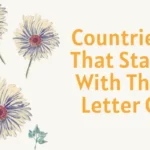The species chosen to populate cottage gardens, wildflower patches, xeriscapes, and skillfully designed flower beds all emanate an obvious beauty.
Flowers That Start with G – List of Flowers Begins with the Letter ‘G’

It can be daunting to sort through the alternatives if you’re planning a new garden or even looking for flowers to fill in spaces in an existing landscape. Here are the names and descriptions of the beautiful flowers that begin with the letter G to get you started.
Galanthus
Bulbous herbaceous perennials are called “snowdrops” with flowers called galanthus. The Amaryllidaceae (family of amaryllises) is the source of these beautiful blooms. Originally from Europe and the Middle East, snowdrops thrive in zones 3 to 8.
Slender, grass-like leaf clusters are how snowdrops grow. These stems produce white blooms with inner and outer tepals that nod in the late winter and early spring. One of the two flowers for the month of January, galanthus blooms stand for renewal, hope, and purity.
Gaillardia
Gaillardia flowers, also referred to as blanket flowers, are perennial or annual plants in the aster or daisy family (Asteraceae). These colorful flowers have center florets in their brightly colored, bicolor blossoms. There are several colors available for blanket flowers, including orange, yellow, red, purple, and white.
Some regions of North and South America are home to these lovely flora that begin with the letter G. Their common name refers to how similar they are to the vibrant blankets made by Native American societies. In USDA Zones 3 to 10, gaillardia flowers grow well.
Garden Nasturtium
Members of the Tropaeolaceae nasturtium family that grow quickly include garden nasturtiums. These perennial, South American-native nasturtiums grow in Zones 9 to 11. Nasturtiums, however, are grown as annuals in cooler climates.
These lovely G-letter flowers are valued for their trumpet-shaped red, orange, or yellow blossoms. These thriving plants are also cultivated for their pale-veined umbrella-shaped leaves. The best way to use the edible blossoms and leaves is in salads during the summer.
Gardenia
Popular evergreen plants called gardenias are native to South East Asia. Cape jasmine is another name for these members of the Rubiaceae family, which includes coffee. For millennia, people have grown these decorative plants.
Glossy, smooth, green leaves with distinct veins are the hallmark of gardenias. Throughout the summer and fall, huge, single white or creamy-yellow flowers appear at the terminals of the stems. Additionally, gardenia flowers have a potent sweet or spicy aroma that stands for clarity, hope, rejuvenation, and trust.
Garden Phlox
Garden phlox, often called summer phlox, is a native of the eastern and central parts of the United States. A popular perennial herb from the Polemoniaceae family is garden phlox. From the height of summer until the beginning of fall, these blooms fill the garden with their lovely scent.
Garden phlox has elliptic leaves and big panicles of tiny purple, pink, or white flowers. In zones 4 to 8, this variety of phlox does well in full sun or light shade.
Gaura
Beautiful herbaceous perennials called gaura flowers have white or pink blossoms. Each flower has four distinct petals that are on one side shaped like a butterfly. Gaura flowers propagate by underground rhizomes and have hairy lanceolate leaves as well.
The family of evening primroses (Onagraceae) is the source of these classy flowers that begin with the letter G. Parts of Texas and Louisiana in the Southern United States are home to gaura flowers. These common ornamentals can tolerate dryness and do well in Zones 5 to 9.
Gentian Sage
Another name for spreading sage is gentian sage, which is a pretty plant. These perennial herb species are indigenous to central Mexico and are members of the Lamiaceae family, which also includes sage. In Zones 8 to 10, gentian sage is perennial; but, in colder climates, it behaves like an annual.
The gentian sage blooms in erect racemes from the summer through the fall. Each flower on sage has two lips, much like other sages. In addition, the stems and leaves of gentian sage are square.
Gazania
Brightly colored gazanias are often referred to as African daisies or treasure blooms. From the daisy family, gazania flowers are indigenous to regions of Southern Africa. These colorful plants are annuals when grown, yet they are perennials in their natural habitat.
Daisy-like blossoms with vibrant yellow or orange petals encircling yellow core florets are produced by gazania flowers. These massive blossoms start to bloom in the late spring and last through the fall. Zones 8 to 11 are ideal for growing gazanias.
Geranium
Popular flowers called geraniums are planted in gardens all around the world. The Geranium genus, also known as cranesbills, is home to more than 400 species of plants in the Gerinaceae family. Although there are numerous species of geraniums worldwide, most are indigenous to the Mediterranean.
These colorful flowers that begin with the letter G are clustered together among palmate leaves that have been deeply divided into numerous leaflets. These well-known plants have pink, purple, or white flowers that resemble cups. Geraniums are planted as annuals in some regions, despite being perennials in Zones 10 and 11.
Geum
Avens, or geums, are attractive, colorful flowers. The Geum genus, which belongs to the Rosaceae family of plants, has about 50 species. Geums are herbaceous perennials that can be found in many different climates.
These well-known G-letter flowers develop in bunches of fern- or fan-shaped leaves. Geums produce tiny red, orange, yellow, or white flowers from late spring to fall. Although geums are typically evergreen, colder climates outside of Zones 3 to 7 may cause them to turn deciduous.
Gerbera Daisy
The Barberton or Transvaal daisy, Gerbera jamesonii, is the ancestor of all cultivated Gerbera daisies, which are widely grown in gardens around the world. From the family of daisies, this species is indigenous to Southern Africa.
The majority of places grow gerbera daisies as annuals despite being herbaceous perennials. Large, daisy-like flowers with red, orange, yellow, or white petals are produced by this appealing plant, which also has dark green leaves with lobes. In rich, ideal-draining soils, gerbera daisies thrive in Zones 8 to 11.
Giant Allium
Giant alliums, sometimes known as giant onions or decorative onions, are colorful, unique bulbous perennials. The enormous, spherical flower heads of these plants are crammed with small, purple flowers that have six star-shaped petals. Additionally, bunches of thin, strap-like leaves are produced by giant alliums.
Some of the nicest alliums, according to me, are these vibrant varieties. Giant alliums thrive in Zones 6 to 10 and are native to central and southwestern Asia. Giant alliums can start blooming as early as late spring and last through the summer.
Giant Spider Lily
The Hymenocallis genus of the Amaryllis family is where giant spider lilies are found. These bulbous perennials, which are native to the Americas, thrive best in Zones 5 to 11, depending on the species.
These exquisite G-letter flowers develop in basal rosettes, which are clusters of thin, strap-like leaves. These rosettes develop unusual white or yellow flowers on stems.
Giant Hibiscus
Giant hibiscus plants are members of the mallow family (Malvaceae), and are commonly called the swamp rose mallow. Wetlands around the southeastern United States are home to giant hibiscus flowers. While growing as an annual in cooler climates, this plant is perennial in Zones 8 through 11.
Grayish-green, heart-shaped leaves, and huge trumpet-shaped blooms are characteristics of giant hibiscus bushes. Each pink or white flower, which may reach up to 10 inches wide, only blooms for a short time.
Join 25,000+ smart readers—don’t miss out!








